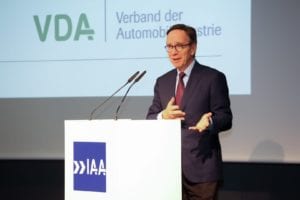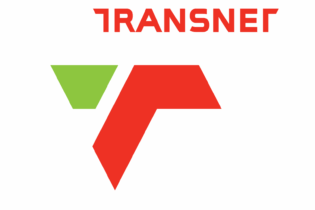Statement delivered by Matthias Wissmann, president of the German Association of the Automotive Industry (VDA), at the VDA’s International Press Workshop in Frankfurt/Main, Germany on June 23, 2016.
The International Press Workshop – IAA Commercial Vehicles – focuses on connectivity and digitalization. The European truck market shows strong growth, which means good prospects for the IAA. Ladies and Gentlemen, I wish you a good morning and a warm welcome to the International Press Workshop in advance of the 66th IAA Commercial Vehicles. There is no doubt that the Western European commercial vehicle market is bolstering the IAA. Last year 259,000 heavy trucks over 6 tonnes were newly registered. That was a rise of a whole 14%. In the first five months of this year, Western Europe has also expanded by 14%. The major markets – France, the UK and Italy – have strong double-digit year-on-year growth. The top performers are Spain and the Netherlands, with growth rates of over 20%. The recovery process is stable and robust, and for the year as a whole, we expect to see a rise of 8%. The Western European van market is also still picking up. Sales of light commercial vehicles showed a double-digit increase in both 2014 and 2015. This dynamic development is continuing: in the first four months, a good 600,000 vans were newly registered. That represents growth of 11%. This year the US truck market, by contrast, will take a breather – following six years of growth in succession. For the year 2016 as a whole, we expect a marked fall in the segment over 6 tonnes. However, in all probability, this will be a temporary, cyclical dip starting from a high level. In China, on the other hand, the market for heavy commercial vehicles is clearly expanding again after two weak years. For 2016 we expect a result of nearly 800,000 new trucks – a rise of 5%. I will now turn to Germany: the German commercial vehicle market is still doing very well. The year 2015 brought a strong 5% rise in heavy commercial vehicles, to over 83,000 units. The first five months of this year were actually even better, with a rise of 9% to just over 36,000 heavy commercial vehicles. The speed of growth may well ease off during the course of the year. For the year as a whole, we expect an increase of 4% to almost 87,000 new trucks. Among vans, too, we expect 2016 to show clear growth of 5% to 256,000 units in Germany. That would be a new record level. The developments in trailers are equally welcome – here new registrations to the end of May were 6% up on the previous year. The trailer manufacturers pushed up their sales by 14% in the first four months of this year. From truck manufacturers to body specialists, the commercial vehicle sector is an important part of the German automotive industry. The German commercial vehicle companies employ almost 190,000 people – which is nearly one-quarter of all employees in the automotive industry. SMEs are also strongly represented in this sector. Many of these companies are manufacturers of trailers and bodies. They have a workforce of nearly 33,000 people. These firms turn a chassis into a complete commercial vehicle. And they are real masters at offering tailored solutions to the varying requirements of their customers. Diesel and manipulation of emissionsThe discussion of exhaust manipulations in diesel cars represents a challenge for all of us. The passenger car OEMs know that they have to prove their credibility again. And they will do everything they can to regain lost trust. But it is also clear that diesel engines have huge strengths and are indispensable for complying with the climate targets. And for heavy goods vehicles, it is especially true that diesel is clean! And because of their efficiency and economy, they will continue to play a key role for a long time to come. I wish to stress explicitly that modern commercial vehicles are exemplary when it comes to exhaust emissions because since 2013 (Euro VI) the emissions from new trucks have been measured during operation. A portable emissions measurement system (PEMS) has been developed for this purpose. This means that for commercial vehicles the measurement of real driving pollutant emissions is already standard. For passenger cars, we have only recently acquired this modern measuring technology. Commercial vehicles are one step ahead of passenger cars here and have proven that extremely low emissions are possible using diesel. Today’s Euro VI trucks and buses have only homoeopathically low emissions – both in tests and in real-world operation. Pollutant reduction for commercial vehicles has been completed successfully. Commercial vehicle manufacturers and the logistics industry want to work together on reducing CO2 emissions. One of the greatest challenges of our time, and therefore one for the commercial vehicle industry, is to bring down CO2 emissions. The EU has set itself an ambitious climate target: a reduction of 30 % by 2030. Commercial vehicles will contribute to achieving this. Making further reductions in the CO2 emissions from road freight traffic is a task involving a large number of stakeholders. The commercial vehicle makers and the logistics operators know that we can only bring CO2 emissions down if we work together. And it would be vastly insufficient to regulate only the vehicles themselves. To achieve the climate targets we will have to tune the entire transport process for CO2 efficiency. For there are far more variables affecting consumption than just the new vehicles and engines. Efficient logistics processes, the infrastructure, driver behaviour, and even the tires have a considerable influence on CO2 emissions. The available fuels also play a major part in the CO2 balance. And for this reason, we need an integrated approach to reducing CO2. The European commercial vehicle manufacturers have put forward specific proposals. An integrated approach could double the annual reduction in CO2 from trucks – to 3.5%!
For this, it is necessary to take into consideration the entire fleets, and not just new vehicles. In addition, we have to optimize not only the vehicles themselves but all the factors that affect the CO2 balance. This is the only way to bring down CO2 emissions effectively.
Commercial vehicles contribute to achieving climate goals. I would like to repeat: commercial vehicles contribute to achieving the climate goals. The OEMs have already considerably decreased their vehicles’ fuel consumption. Since the 1970s they have achieved a reduction of around 60 % per tonne-kilometre – and that is without any legal regulations on consumption. A comprehensive, integrated approach can reduce the CO2 emissions from new trucks by another 20 % compared to 2005 values by 2020. Incidentally, European trucks are already top class when it comes to fuel economy: in contrast to what is sometimes said, their average consumption today (in litres per tonne-kilometre) is far below that of their counterparts in the US. This is the result not of a legal regulation, but of the tough competition. The absolute CO2 champion among the modes of transport is naturally the bus: 32 grams per passenger per kilometre on average for long-distance buses. That’s unbeatable! Powertrain strategy: further optimization of diesel, alternative powertrains becoming more and more important to make further progress, we must continue optimizing today’s available modern powertrains. Yet alternative powertrains are becoming increasingly important. For example, natural gas is already being used to power buses, and for trucks, it also offers the potential of decreasing CO2 output. A good infrastructure for supplying and filling up on gas is essential for widespread use. The EU’s “Clean Power for Transport” initiative envisages a Europe-wide network of natural gas filling stations. This must be swiftly followed up with action. Hybrid and electric drives are also becoming more and more attractive for transport, above all in light commercial vehicles used for distribution and deliveries. That is because the large cities continue to grow, as does internet trading. This means that in the future light, electrified commercial vehicles suitable for urban use will become even more important. To complete the picture one has to bear in mind that technological innovations lowering emissions also generate higher costs in the foreseeable future. The costs of avoiding CO2 are much higher in vehicle construction than in other sectors. We, therefore, need a reliable regulatory framework for launching new technologies onto the market. The promotional program announced for the forwarding and transportation sector in Germany is intended to send out a powerful signal supporting effective, fuel-saving technologies. Freight traffic needs both efficient roads and a high-performance rail system in order to manage the growing quantities of freight traffic in an environmentally friendly manner; we will need more than just trucks. We will need all modes of transport: an efficient road network, a high-performance rail system, and the inland waterways – with better connectivity. After all, we can assume that there will be further strong growth in freight traffic. In the parcel and courier services, the volume has increased by 74% in the past 15 years – driven principally by internet trading. It is to our advantage if a modern freight rail system absorbs a large proportion of this growth. However, at the same time trucks will still have to bear the lion’s share of these goods, and today in Europe they carry 75%. Long trucks: up to 25% less CO2. It will, therefore, be necessary to apply innovations such as long trucks. They have been undergoing field trials in Germany for the last four and a half years – with very positive results: CO2 output per tonne transported can be reduced by up to 25%. The field trials have also shown that long trucks do not cause a shift from rail to road transport. We should now draw conclusions from this: we need a regular operation in Germany – on the approved network that has already proved itself in the field trial and can be extended. Trucks of the future will be connected, automated, and digital What will the future of trucks be like? The answer is obvious: connected, automated, and digital. This is where we will see the next innovative leap forward in road freight traffic. Only a few weeks ago, in the European Truck Platooning Challenge, the European truck manufacturers showed just what is already technically possible. Driving in platoons can save up to 10% of fuel and CO2 emissions. But above all this example shows what potential there is in connectivity: it offers the chance to handle the quantities transported even more efficiently and to cope with the growth in an efficient manner. Commercial vehicles are predestined for automated driving. The technology makes traffic safer, improves the workplace for drivers, and reduces CO2 emissions and operating costs. For this we need a discussion focused on the opportunities, without losing sight of the challenges. The efforts pay off. Data are the gold of the digital age. Trucks supply valuable information just as a by-product – about the vehicle, the load, the road, traffic situation, weather and a lot more besides. Now we need to find the right applications that will further optimize day-to-day transport. We have a huge opportunity to set new standards with mobility and transport technology “made in Germany.” IAA Commercial Vehicles: Driven by ideas Connectivity and digitization are also the main themes at the upcoming IAA. We are demonstrating this in particular at the New Mobility World logistics. Last year at the IAA Cars in Frankfurt we successfully established the New Mobility World as the European forum for all aspects surrounding the connected, digital mobility of the future. In Hannover, we will show how road freight traffic and logistics will continue to develop in the age of new mobility. You can see and experience live everything that we talk about today at the IAA Commercial Vehicles in Hannover from September 22 to 29, 2016. “Driven by ideas” is the appropriate slogan for the IAA Commercial Vehicles. And one could also regard it as the leitmotiv of the commercial vehicle industry. The IAA is not only the largest and most important commercial vehicle show anywhere in the world, but it is the world’s most important trade show for mobility, transport and logistics. The preparations are running at top speed. We have a very good number of registrations. We are already looking forward to welcoming you to Hannover in September!







